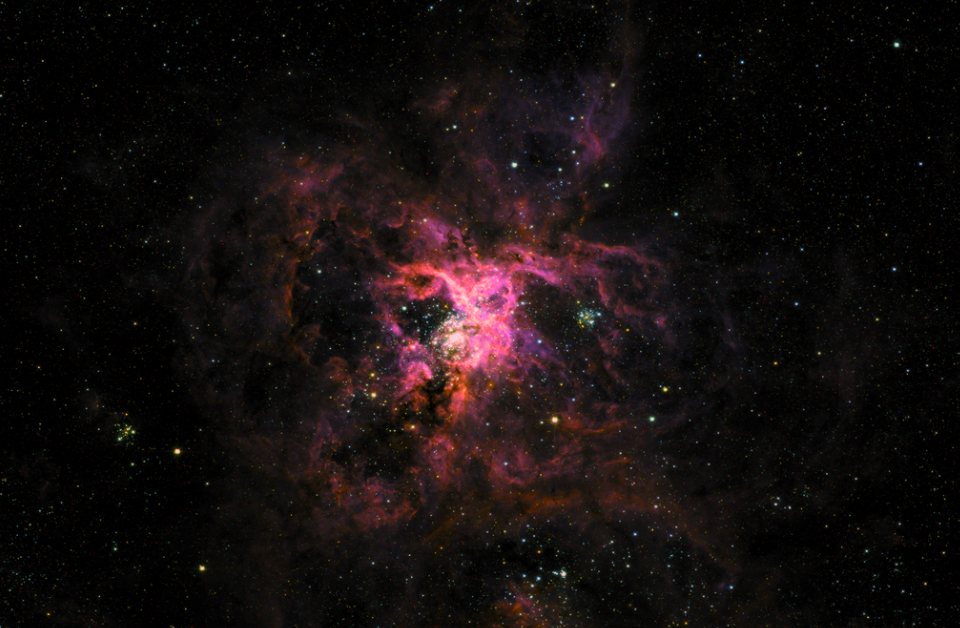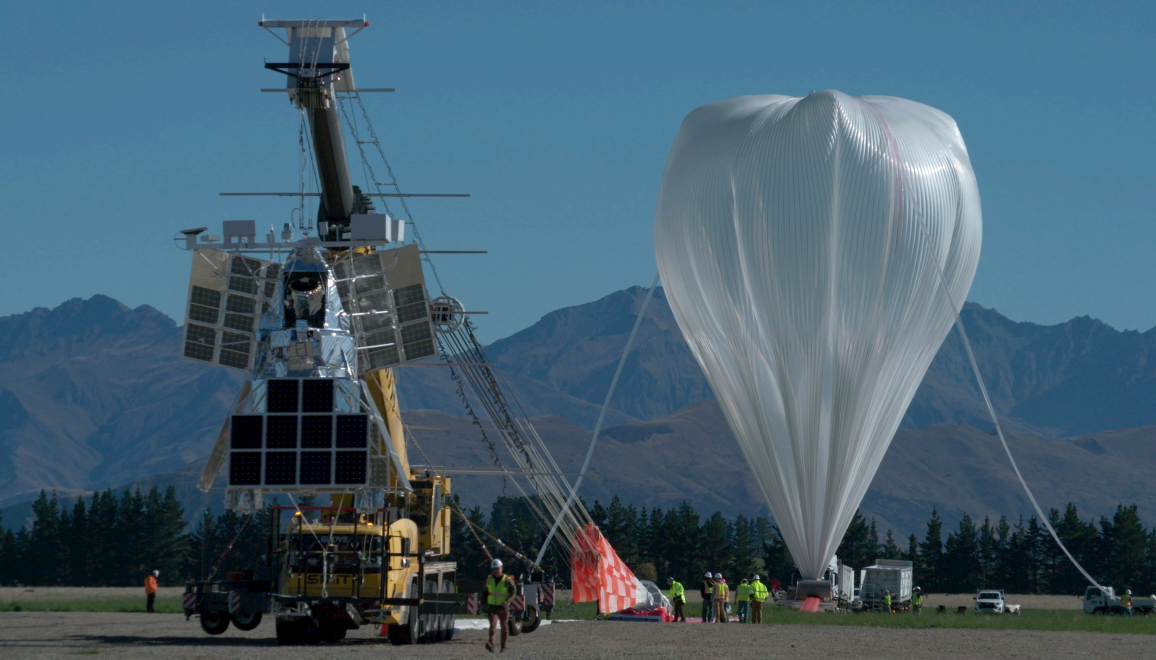My research lies at the intersection of cosmology, space systems, instrumentation, small satellites, suborbital missions.
What is the nature of dark matter and dark energy? Dark energy and dark matter make up 95% of the universe. Dark matter, which makes up 25%, is an unknown form of matter that is observed only through its gravitational effects. Dark energy, which makes up 68%, is an unknown form of energy causing the expansion of the universe to accelerate over time.
Dark matter: Is it a particle? If so, what are its properties? Does it interact with normal matter? Does it interact with itself? What impact does it have on the formation of structure in the universe? To address these questions, I work on experiments to probe dark matter in galaxy clusters, the largest gravitationally bound objects in the universe.
Dark energy: I am particulary interested in the question of whether the dark energy density changes with time. This is critical to measure, as the value of dark energy density has profound implications for the eventual fate of the universe— whether it will continue to expand forever or eventually slow down and collapse back down!
Is there life elsewhere in the universe? There are various methods for learning about the potential for extraterrestrial life in the universe. One approach is to develop instruments called coronagraphs, that are designed to directly image exoplanets and measure their spectrum, with the aim to search for biosignatures indicating the presence of life. From an instrumentation perspective, I am interested in validating autonomy and machine learning techniques for wavefront sensing and control for adaptive optics systems used in coronagraphs.
Can we develop low-cost small satellite and suborbital missions to conduct cutting-edge scientific research? Space telescopes have traditionally been expensive and slow to develop. However, lowering launch costs and advances in sensor technologies are paving the way to a future in which small teams at individual institutions can design, develop, and launch low-cost missions to conduct cutting-edge science research. I am interested in leveraging these advances to develop new low-cost, innovative, small satellite missions for astronomy.
Cosmology from suborbital missions: SuperBIT and GigaBIT
Since dark matter does not interact with light, we observe it through its gravitational effects, particularly through weak gravitational lensing (WL). WL allows us to map the distribution of dark matter in galaxy clusters by precisely measuring the lensed shapes of background galaxies. However, since this effect is very small (~1%), WL measurements are ideally conducted from space telescopes that are not affected by atmospheric turbulence. SuperBIT is a 0.5-meter, 300—1100 nm balloon-borne telescope that conducted WL observations of 30 merging clusters during its 45-night stratospheric flight. In addition to dark matter science, SuperBIT achieved key technical milestones, including measuring the optical night sky backgrounds from the stratosphere (Gill et al. 2020), precision pointing and stabilization (0.05”-1σ), diffraction-limited imaging, and autonomous operations (see Gill et al. 2024 for flight performance results). Building and operating an instrument like SuperBIT is a challenging process.
Looking ahead, GigaBIT will be a 1.34-meter suborbital mission and will serve as a successor to SuperBIT. GigaBIT will be ideal for addressing a broad range of astrophysics and cosmology questions, including the nature of dark matter and dark energy. GigaBIT is planning a test flight in 2027.
SuperBIT is designed for precision pointing at an astronomical source and providing ultra-fine stabilization at the focal plane at the level of 50 milliarcseconds, which is equivalent to threading a needle from a distance of 15 football fields away. High pointing stability and near diffraction-limited imaging is critical for galaxy shape measurements in weak gravitational lensing. See Gill et al. 2024 for further technical details and the flight performance results. This video shows SuperBIT performing a slew during integration in Wanaka, NZ.
Tarantula nebula observed by SuperBIT during its 2023 flight.
SuperBIT on the launch pad in Wanaka, NZ. Image credit: Bill Rodman/NASA.
A documentary focused on developing SuperBIT can be seen below.
Cosmology with the cosmic microwave background: the Atacama Cosmology Telescope and the Simons Observatory
When photons from the cosmic microwave background (CMB) encounter high energy electrons in galaxy clusters, they gain energy through the thermal Sunyaev-Zel’dovich (tSZ) effect. The bulk motion of the clusters also imparts a distortion to the CMB spectrum via the kinematic SZ effect (kSZ). The tSZ and kSZ effects are an excellent probe for several properties of galaxy clusters, including the gas pressure, the optical depth, the temperature, and the presence of shocks. In addition, the abundance of galaxy clusters in the universe is sensitive to the equation of state of dark energy. Finally, while the kSZ is much weaker than the tSZ effect, multi-frequency observations using high-resolution CMB maps may have the constraining power to measure the kSZ effect in individual galaxy clusters, provided that all other sources of emission can be properly modelled and subtracted. The distribution of peculiar velocities of individual galaxy clusters is a sensitive, independent probe of whether dark energy is evolving over time. I study the tSZ and kSZ effect in galaxy clusters using microwave observations from the Atacama Cosmology Telescope, the Planck satellite, and the upcoming Simons Observatory.
Observations of the cosmic microwave background from the Planck satellite (left), ACT+Planck (middle), and ACT only (right). See Naess et al. (2021) for further details.
The Atacama Cosmology Telescope (ACT) and its successor, the Simons Observatory, are high-resolution microwave observatories at the Atacama Dessert measuring the cosmic microwave background radiation from the early universe (image credit: ACT Collaboration).
Dark matter and dark energy are unknown forms of energy density comprising 95% of the universe. My past (blue) and future (red) research aims to probe dark matter and dark energy via instrumentation and observations.
Small satellites
I am collaborating with the University of Toronto to develop a low-cost, ITAR-free, space UV/optical camera. I developed a detector characterization system to measure key parameters of the sensor (Gill et al. 2022). The camera (LUVCam) is currently on orbit aboard the GRBBeta CubeSat and will serve as the science detector for the QUVIK space telescope (Dániel et al. 2024), which will the early UV emission from kilonovae events in the universe. At the MIT STAR Lab, I am part of NASA’s CubeSat Laser Infrared CrosslinK (CLICK) mission. CLICK B/C consists of two 1.5U payloads aboard 3U buses, set for launch in 2025. This mission will demonstrate optical transceiver technology for both downlink and crosslink. The data rate will be >20 Mbps over crosslink ranges of 25 km to 580 km. CLICK B/C will also demonstrate precision ranging, with an accuracy better than 50 cm, as well as time transfer, with an accuracy of 200 picoseconds.
The CLICK B/C mission consists of two 1.5U payloads that will demonstrate optical communication crosslink on orbit, as well as laser precision ranging, and time transfer. Image credit: CLICK Collaboration.
Photon transfer curve of the Sony IMX 455 sensor constructed using my detector characterization setup (Gill et al. 2022). This sensor eventually fly as the science detector on the SuperBIT suborbital flight.
Radio astronomy and instrumentation
I have worked on a variety of radio astronomy and instrumentation projects in the past.
Instrumentation to localize Fast Radio Bursts, Long Wavelength Lab, University of Toronto
Fast radio bursts (FRBs) are millisecond-duration pulses from the universe observed with radio telescopes. They seem to arrive uniformly from all directions, and their physical origin remains a mystery. At the Long Wavelength Lab at the University of Toronto (under Prof. Keith Vanderlinde), I worked on upgrading the receiver electronics for the 10-meter Algonquin Radio Observatory (ARO) in Ontario. The objective of this work was to cross-correlate Fast Radio Bursts (FRBs) detected with both the Canadian Hydrogen Intensity Mapping Experiment (CHIME) in British Columbia and the ARO. This is useful, as it allows for the precise localization of the FRBs to their host galaxies, which is essential to learn more about the physical origin of FRBs. See Cassanelli et al. 2022 for further details. During this work, I was also part of the team that discovered the second source of repeating FRBs in the universe, revealing the heterogeneous nature of FRBs (CHIME/FRB Collaboration 2019).
The 10-meter dish at the Algonquin Radio Observatory (Cassanelli et al. 2022).
Water vapor radiometery for the Very Large Array, National Radio Astronomy Observatory, Socorro, NM
Variations in the index of refraction in the atmosphere leads to phase fluctuations for radio waves arriving from astronomical sources. A water vapor radiometer (WVR) can be used to measure the brightness temperature from water vapor along the line of sight of the telescope. These temperature variations can then be used to correct for the phase fluctuations. I characterized a 5-channel WVR for the phase calibration of the Karl G. Jansky Very Large Array (VLA), under Robert Selina and Dr. Rick Perley. The results from this work can be found at EVLA memo 203.
Phase fluctuations of radio astronomy signals resulting from index of variations in the atmosphere (image from Desai 1995).
Improving the efficiency of VLBI correlation, Center for Astrophysics, Harvard & Smithsonian
I explored the potential of enhancing the efficiency of VLBI correlations for the Event Horizon Telescope (EHT) project, which aims to study the properties of black holes through radio interferometric imaging. The results of my work can be found at Gill et al. 2019.
X-ray emission mechanisms in the radio lobes and the environments of radio galaxies, Physics and Astronomy, University of Manitoba
We studied the diffuse X-ray emission associated with the radio lobes and the hot gas in the intracluster medium (ICM) for a sample of radio galaxies. We used shallow (∼10 ks) Chandra observations for 60 radio galaxies (0.0222 ≤ z ≤ 1.785) selected from the 298 extragalactic radio sources in the 3CR catalog. Using Bayesian statistics, we looked for asymmetry in the extended X-ray emission between regions that contain the radio lobes and regions that contain the hot gas in the ICM. In the broadband (0.5−7.0 keV), we found that the non-thermal X-ray emission from the radio lobes dominates the thermal X-ray emission from the environment. We found that the non-thermal emission from radio lobes tends to increase with redshift compared to the off-jet axis thermal emission. This suggests that the dominant X-ray mechanism for the non-thermal X-ray emission in the radio lobes is due to the inverse Compton scattering of CMB photons by electrons in the radio lobes. For further details, see Gill et al. (2021). I did this work under Dr. Christopher O’Dea and Dr. Stefi A. Baum.
R is a measure of whether there is higher X-ray emission in regions in radio galaxies that contain radio lobes (R > 1) or regions in the hot environment of radio galaxies that do not contain radio lobes (R < 1). In the broad (0.5—7.0 keV) band of Chandra, we found that R increases as a function of redshift. This suggests that the on-jet X-ray emission is due to the inverse Compton scattering of CMB photons by hot electrons, a non-thermal process for which the observed flux is roughly redshift independent due to the increasing CMB energy density with redshift.









